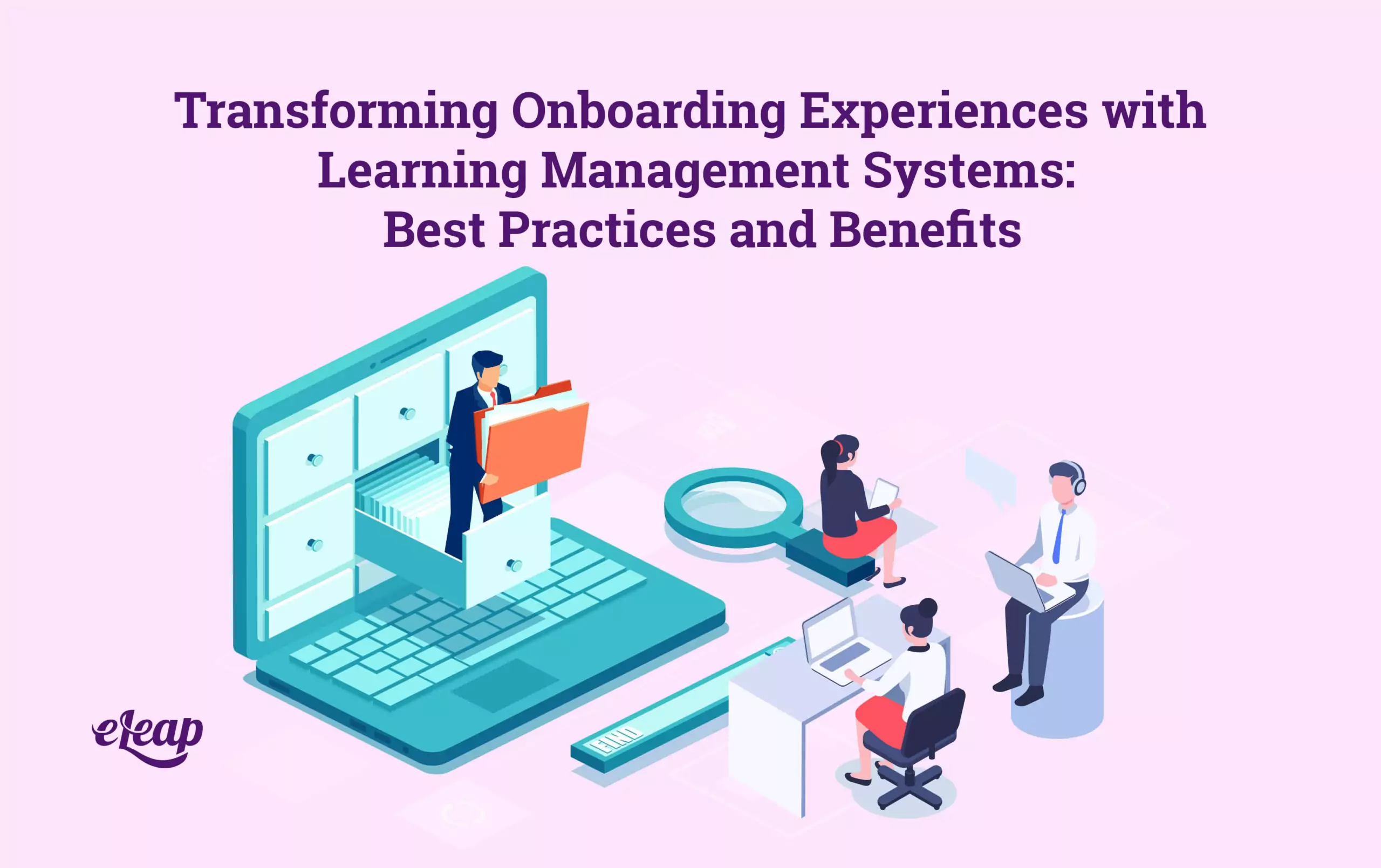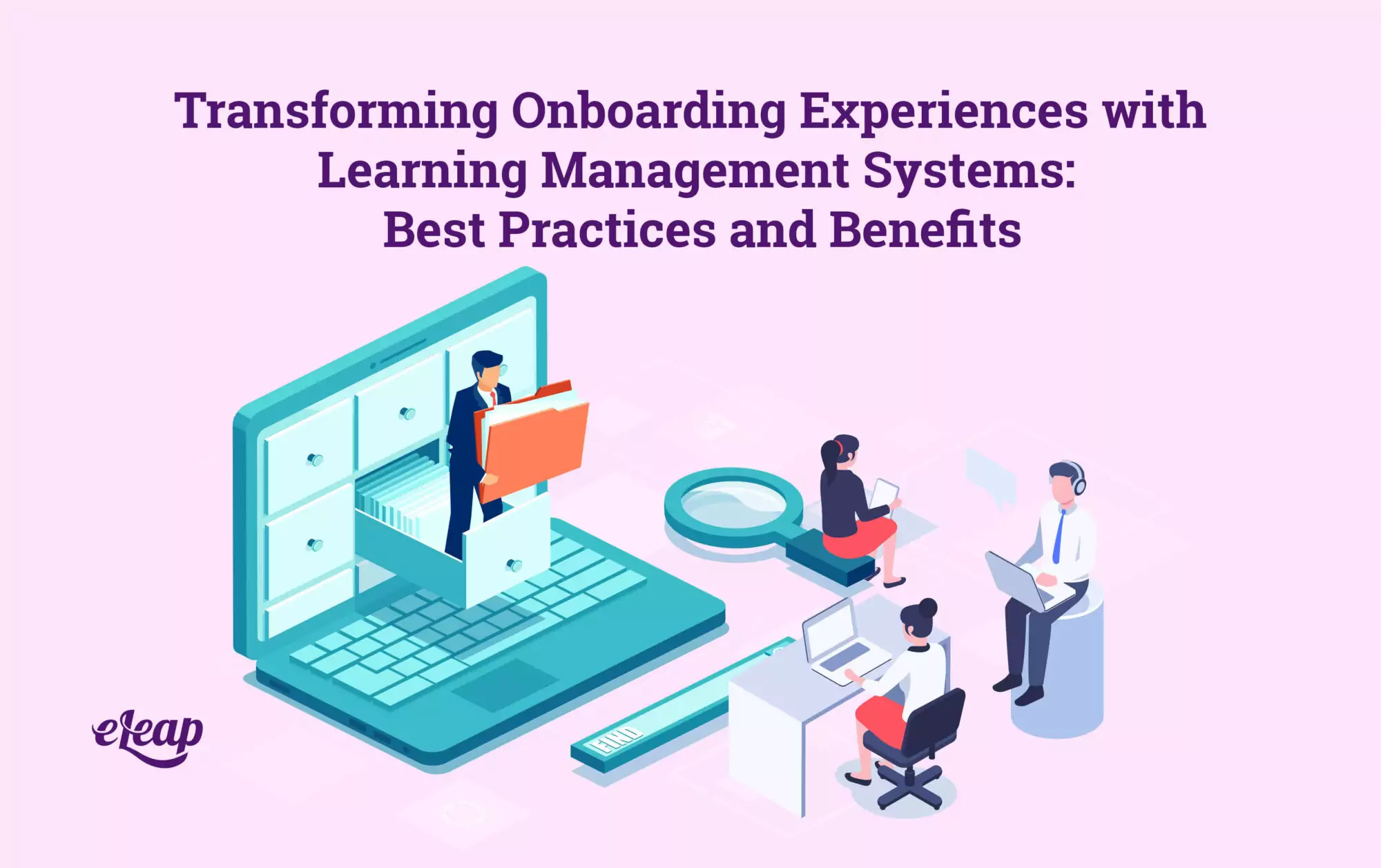Transforming Onboarding Experiences with Learning Management Systems: Best Practices and Benefits

There’s a crisp chill in the air as John, a software engineer, steps into the towering headquarters of his new company on his first day. He is greeted with friendly smiles and an avalanche of paperwork – contracts, manuals, policy documents, and more. Overwhelmed, John spends his first week wading through a torrent of information, trying to understand his role in the enormous organization. The process is intimidating, draining, and disengaging.

Now, let’s reimagine John’s first day with his new company. Only this time, instead of the daunting mountain of paperwork, John is introduced to a comprehensive digital Learning Management System (LMS). He logs in to find a personalized dashboard featuring a gamified onboarding program. There are interactive videos about the company culture, bite-sized eLearning modules tailored to his job role, virtual team-building activities, and immediate feedback on quizzes to validate his understanding.
John feels engaged, informed, and connected. Instead of a taxing initiation, his onboarding process becomes an exciting journey of discovery. He learns at his own pace, interacts with his new colleagues, and seamlessly integrates into the company, thanks to the power of an LMS.
This second scenario is not merely a figment of our imagination but a reality within reach of organizations today. The power of Learning Management Systems (LMS) is transforming onboarding experiences, converting them from exhausting information dumps into interactive, engaging, and empowering learning journeys.
Transforming Onboarding Experiences with LMS
An LMS provides a consolidated digital platform for learning content, providing organizations with the tools to develop, deliver, and manage a wide range of learning and development programs. For onboarding, these digital platforms are especially transformative, streamlining the process of welcoming new employees and setting them up for success.
Traditionally, onboarding could be an inconsistent process, varying in quality depending on the person delivering it. It often included a substantial amount of paperwork, face-to-face meetings, and potentially long periods of unproductive time for the new employee. By moving this process to an LMS, organizations can create a standardized, high-quality onboarding experience that can be consistently delivered to every new hire. Moreover, it ensures that new employees get the necessary information whenever and wherever they need it, without the limitations of time or place.
Best Practices for LMS Onboarding
Customize the Onboarding Content
Each business has its unique culture, values, and operations. Therefore, it is essential that the onboarding process reflects this uniqueness. An LMS enables the customization of onboarding materials and courses, allowing organizations to create content that truly represents their work ethos.
For example, an organization could create custom modules introducing its history, leadership team, values and goals, key products or services, and specific responsibilities and expectations of the new role. Such content helps new hires feel connected to the organization from day one.
Incorporate Interactive Elements
Interactivity plays a crucial role in online learning. Interactive elements such as quizzes, simulations, discussion forums, and multimedia content (like videos and interactive diagrams) can significantly enhance the engagement and effectiveness of the onboarding process.
For instance, incorporating quizzes after each module can reinforce learning and help identify areas where the new employee may need additional support. Similarly, discussion forums can facilitate social learning and encourage new hires to ask questions and share insights.
Use Microlearning Modules
Microlearning refers to the strategy of delivering content in small, specific bursts, usually five to ten minutes long. This approach accommodates the attention span of the modern learner and aligns with how our brains are wired to learn.
Microlearning can be particularly effective in the onboarding process. For instance, instead of overwhelming a new hire with a 2-hour course on the company’s safety procedures, the same content could be broken down into twelve 10-minute modules. This approach not only makes the learning process more manageable but also improves knowledge retention and application.
Track Progress and Give Feedback
An LMS like eLeaP comes with built-in tracking and reporting features. These can help you monitor a new hire’s progress through the onboarding program, assess their understanding of the content, and identify any potential gaps in their learning.
You can also provide real-time feedback to the new hires, acknowledging their achievements and providing constructive suggestions for improvement. This interactive feedback process can foster a positive learning experience, encouraging the new hires to engage more deeply with the content.
Benefits of Using LMS for Onboarding
Consistency and Compliance
Using an LMS for onboarding ensures a consistent learning experience for all new hires, regardless of their location or time zone. Every new employee receives the same high-quality, comprehensive introduction to the company and their role, which fosters a unified company culture.
In terms of compliance, an LMS can help maintain records of who has completed mandatory training, which is particularly important for companies in highly regulated industries. You can also update the compliance training materials on the LMS as per the changing regulations, ensuring that your training content always remains up-to-date.
Reduced Costs
Traditional onboarding methods often involve physical materials, travel, and considerable time investment from various team members. An LMS, on the other hand, significantly reduces these costs.
First, since the learning materials are stored and delivered online, you eliminate costs associated with printing and distributing physical materials. Second, an LMS allows new hires to access the onboarding program from wherever they are, removing any travel expenses. Third, once the onboarding content is developed and uploaded on the LMS, it can be reused for multiple new hires without requiring additional time from your team members. You can also easily update the content when needed, making the LMS a cost-effective solution for onboarding in the long run.
Improved Employee Engagement
An LMS can make the onboarding process more interactive and engaging compared to traditional methods. For example, gamification features, like badges, points, and leaderboards, can make learning more fun and motivate new hires to engage with the content.
Additionally, social learning features, such as discussion forums, can help new hires feel connected with their peers and the larger organization. They can share their thoughts, ask questions, and learn from each other, creating a more engaging and collaborative learning environment.
Increased Productivity
A well-structured LMS onboarding program can fast-track a new hire’s journey to full productivity. By providing new employees with easy access to essential information about their job and the company, you enable them to understand their roles quicker and start contributing sooner.
Moreover, the self-paced nature of LMS-based learning allows new hires to learn at their own pace, revisit the content whenever needed, and fit the learning around their work schedules. This flexibility can lead to more effective learning and quicker application of new knowledge and skills on the job.
LMS in Action: The Example of Dell
Dell is a prime example of a company that has utilized LMS to transform its onboarding process. The multinational technology company has over 100,000 employees across different continents. The challenge of delivering consistent and effective onboarding to such a large and diverse workforce was substantial.
To tackle this, Dell turned to an LMS. The company was able to create a comprehensive onboarding program featuring a range of multimedia content and deliver it to every new hire, regardless of their location. This not only ensured a consistent onboarding experience but also significantly reduced the time and costs associated with onboarding.
As a result, new hires at Dell were able to understand their roles and the company better and faster, thereby reaching their full productivity levels more quickly. Dell’s example demonstrates the transformative power of an LMS in modernizing the onboarding process.
Conclusion
In an ever-evolving business landscape, one thing remains constant: the importance of people. The key to every organization’s success lies in its employees, and the first step towards harnessing that success begins with effective onboarding.
Through the use of Learning Management Systems (LMS), we can transform onboarding from a passive, administrative chore into a dynamic, engaging learning journey. This transformation not only equips new hires with the necessary knowledge and skills but also inculcates a sense of belonging and motivation right from the start.
But the journey doesn’t end with the implementation of an LMS. It’s essential to continually review and enhance the content and structure of the onboarding program based on the feedback and performance of the new hires. After all, an LMS is a tool, and its effectiveness depends on how we use it.
Moreover, an LMS is more than just a platform for delivering onboarding content. It’s a window to your company’s culture, values, and vision. It’s the first impression new hires get about how your organization values learning and development. Therefore, it’s crucial to align your onboarding program with your company’s ethos and goals.
The impact of a well-executed, LMS-enabled onboarding process goes far beyond the initial days of a new hire. It sets the tone for the employee’s journey with your organization, affecting their job satisfaction, productivity, and long-term retention.
So, as we embrace the future of onboarding, let’s not just view Learning Management Systems as platforms for training delivery. Instead, let’s recognize them as strategic tools for employee engagement, performance, and retention because the future of onboarding isn’t just about digital platforms and interactive content. It’s about people, their learning experiences, and their growth. And that’s a future worth investing in.